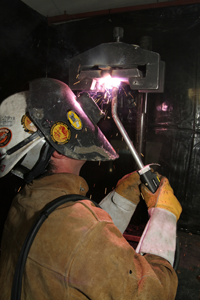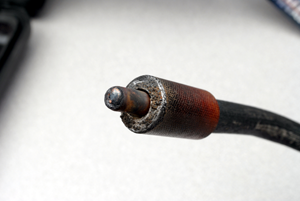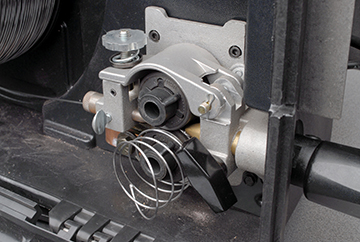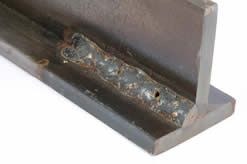Your FAQs About FCAW-SS Problems Answered

For structural steel applications, bridge construction and heavy equipment repair, self-shielded flux-cored welding (FCAW-SS) has become a standard and reliable process due to its ability to provide high-deposition rates and good weld quality. It also provides the chemical and mechanical properties necessary to withstand low temperatures and is equally well-suited for ship and barge construction applications. Like every welding process, however, self-shielded FCAW has its challenges. From selecting the right power source and welding gun to determining the best filler metal for the application, it’s important to take care with each component in order to obtain the best welding performance. It’s also important to know the causes of and solutions to problems when they arise. Doing so can save you time, money and frustration.
Here are some frequently asked questions about self-shielded FCAW problems, along with some advice on how to remedy them.
What are slag inclusions and how can I prevent them?
Slag inclusions are common problems that can arise during the self-shielded FCAW process. They occur often in out-of-position welding and are the result of molten flux from inside the welding wire becoming trapped inside the weld. The potential for slag inclusions is also prevalent during multi-pass welding applications.
There are several ways to prevent slag inclusions. First, be certain to maintain the correct travel speed and angle. When welding in the vertical-up position, keep your gun’s drag angle between 5 and 15 degrees and increase it as necessary if the problem still occurs. If you are welding in the flat or horizontal positions, maintaining a drag angle between 15 and 45 degrees should prevent the problem. Secondly, always use the filler metal manufacturer’s recommended voltage for your welding wire to ensure that you are maintaining the proper heat input. Too low of heat input can cause slag inclusions. Other ways to prevent slag inclusions include cleaning thoroughly between weld passes to remove any slag (use a chipping hammer, grinder or wire brush) and correct bead placement. Allow enough space in the weld joint, especially on root passes and wide groove openings, for the weld metal to fill it.
How can I prevent burnbacks?

Burnbacks are the result of the welding wire melting into a ball and fusing to the end of the contact tip, and they are a common cause of downtime in the self-shielded FCAW welding process. There are two main causes of this welding problem. Holding your gun too close to the joint or workpiece can cause burnbacks, as can using too low of a wire feed speed. You can prevent the problem by maintaining a work-to-contact-tip distance of no more than 1-1/4 inch. Also, use the correct wire feed speed for your application. When in doubt as to what that wire feed speed should be, contact your local welding distributor and/or consult the manual provided with your wire feeder.
Why does lack of fusion occur?
Lack of fusion often often occurs as the result of an improper gun angle. If you do not place the stringer bead in the proper location at the joint, the weld metal will fail to fuse completely with the base metal. This problem can also occur in multi-pass welding applications if the weld metal does not fuse with the preceding weld bead. A dirty work surface can also be the culprit.
To prevent lack of fusion, be sure to clean thoroughly before the initial weld pass and in between passes if you have a multi-pass application. Adjust your work angle or widen the joint groove so that you can fully access the bottom of the joint. Maintain a gun angle drag of 15 to 45 degrees or hold the arc on the groove’s sidewall if you are using a weaving technique. Consider increasing your voltage range if you experience lack of fusion and adjust your wire feed speed and your travel speed until you see complete weld fusion.
What are the causes of and solutions for bird-nesting?

Bird-nesting can be caused by a number of factors. This tangle of wire, which prevents the wire from feeding properly through the wire feeder and gun, is often the result of using the wrong drive rolls in your wire feeder and/or setting the wrong drive roll tension. To prevent the problem, use knurled V- or U-groove drive rolls, as these prevent the soft FCAW wire from compressing. Also, set the proper drive roll tension by first releasing the tension on the drive rolls, then increasing it slightly while you carefully feed the wire into a gloved palm. Continue increasing the tension until you reach a half-turn past wire slippage. As with using the correct drive rolls, the proper drive roll tension keeps the FCAW wire from being crushed.
Issues with the gun liner can also cause bird-nesting. These include using an improperly trimmed liner or using the wrong size liner for the given diameter of FCAW wire. To prevent bird-nesting, trim the liner according to the manufacturer’s recommendation, and make sure that there are no sharp edges on it afterward. Inspect your liner on a regular basis to look for blockages, and replace the liner if you find any.
What can I do to ensure I get the best joint penetration?
Good joint penetration is essential to having high-quality, sound welds, and the goal is to prevent too much or too little weld metal going into the joint. To prevent excessive penetration (weld metal melting through the base metal and hanging under the weld), maintain the proper heat input for your application. Lower your voltage range if the problem occurs, while also decreasing your wire feed speed and increasing your travel speed. Conversely, if you find that you are not gaining enough penetration into the weld joint (called lack of penetration — the shallow fusion between the weld and base metal), increase your voltage range and wire feed speed, but reduce your travel speed. Remember, too, to prepare your joint properly. You need to be able to access the bottom portion of the groove in order to maintain the proper wire extension and obtain the arc characteristics needed for a good quality weld. When possible, prepare the joint so that the material you are welding isn’t too thick.
What can I do to prevent porosity?

The best prevention against porosity — a weld defect that occurs when gas becomes trapped in a weld — is to clean your base material thoroughly before welding. Be certain to remove all dirt, rust, grease or oil, paint and other potential contaminants along the full length of the joint you plan to weld. When you begin welding, maintain a wire extension of no more than 1-1/4 inch beyond the end of the contact tip. For some applications, using a filler metal that contains additional deoxidizers can help prevent porosity, as these products can often weld through light contaminants. Remember, however, no filler metal should be a replacement for proper cleaning procedures.
More FAQs?
Like any welding process, there are a number of challenges you may encounter with self-shielded FCAW and those discussed here are by no means an exhaustive list. A trusted welding distributor and a welding equipment manufacturer are both good resources to help you address problems related to wire feeding, weld quality and more. And remember, the more that you know about the causes of welding problems, the faster you can resolve them and get back to work.


